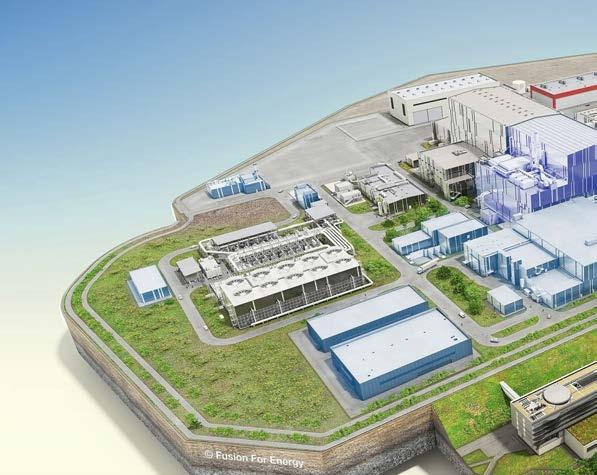
53 minute read
Safety in fusion
from Fusion Energy
by IAEA
ITER: The world’s largest fusion experiment
By Wolfgang Picot
Weighing 23 000 tonnes and standing at nearly 30 metres tall, ITER will be an impressive sight to behold. This nuclear fusion reactor will sit at the heart of a 180-hectare site, together with auxiliary housing and equipment. The immense scale of ITER, Latin for “the way”, will considerably outsize the largest experimental fusion reactors currently in operation — the Joint European Torus (JET) in the United Kingdom and the joint European–Japanese JT-60SA in Japan.
But what is ITER’s potential, and, in an era of miniaturization and optimization, why is it necessary to build a research device on such a gigantic scale?
One of ITER’s primary goals is to prove that fusion reactions can produce significantly more energy than the energy supplied to initiate the reaction process — resulting in an overall gain in power. Reactors like ITER are called tokamaks (see article, page 6), and use a combination of heating systems, strong magnets, and other devices to create energy-releasing fusion reactions in super-hot plasmas. The resulting magnetic fields bind and spin the charged particles around the doughnut-shaped reactor vessel so that these can fuse and produce fusion energy. As for the question of size, larger tokamaks provide better insulation and confine the fusion particles for longer, thus producing more energy than smaller devices.
A significant indicator of a reactor’s performance is its fusion power gain, or the ratio between the fusion power produced and the power injected into the plasma to drive the reaction. It is expressed by the symbol ‘Q’.
To date, JET has achieved the best gain, with a Q value of 0.67, by producing 16 megawatts (MW) of fusion power from 24 MW of heating power. Much higher Q values will be needed for electricity production, however.
Prerequisites for power
Over the past 50 years of fusion experimentation, the performance of fusion devices has increased by a factor of 100 000, but a further increase by a factor of 5 is needed to arrive at the level of performance required for a power plant. To achieve this, researchers are working to optimize the plasma’s condition through changes in temperature, density and confinement ime (see article on page 8).
Some of these improvements have been the result of experimental fusion reactors becoming larger. With ITER’s height and radius being twice that of JET’s, its plasma volume will increase tenfold. Applying novel designs and innovative materials, ITER will also integrate some of the most powerful plasma-heating devices ever used. With the injection of just 50 MW heating power into the plasma, it aims to produce 500 MW of fusion power — giving a Q value of at least 10 — in pulses that are each roughly 5–10 minutes long.
ITER’s peak performance will be impressive, but it will only be reached for a very short amount of time. To become a steady source of electricity, future fusion power plants will need to operate continuously. A Q value of five represents a critical threshold, above which the plasma starts heating itself to sustain the fusion reaction on its own. To better understand how to achieve this selfsustaining reaction, ITER aims to eventually generate and maintain Q values of five for periods much longer than ten minutes.
A global collaboration
ITER’s 35 participating nations represent more than half of the world’s population and 85 per cent of global gross domestic product (GDP). While many other smaller fusion experiments are under way globally, most of them still coordinate, cooperate, or collaborate with the ITER Organization.
The IAEA and the ITER Organization have had a close relationship from the very beginning, particularly in the areas of nuclear fusion research, knowledge management, human resources development, and educational activities and outreach. The IAEA also helps the ITER Organization share their experiences in nuclear safety and radiation protection with IAEA Member States, including those not participating in the project. This year, the ITER Organization, together with the French Alternative Energies and Atomic Energy Commission (CEA), will co-host the 28th IAEA Fusion Energy Conference.
It is hoped that ITER will prove the scientific and technological feasibility of fusion power production and, under its staged-approach research plan, will start conducting its first experiments in 2025. Full-power experiments should commence in 2035. If successful, these developments will be a significant milestone and will represent a historic bridge between experimental research and the first demonstration fusion power plants, or DEMOs (see article, page 12). Envisioned DEMOs will achieve a net electrical energy gain. Multiple preliminary concepts for DEMO-type reactors are already under consideration. If everything goes according to plan, they could be in operation by mid-century. ITER construction site.
(Photo: ITER)
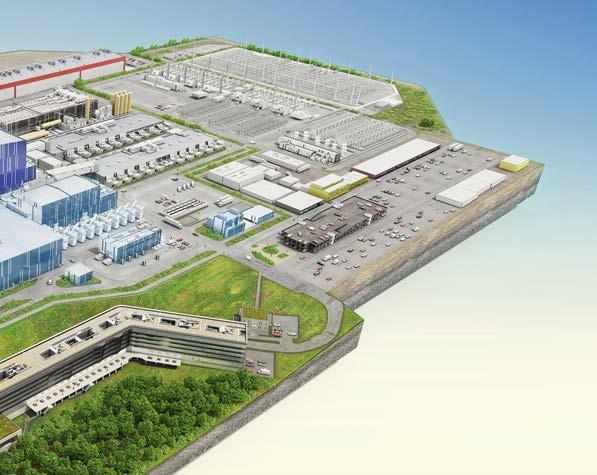
— Elizabeth Surrey, Head of Technology, United Kingdom’s Atomic Energy Authority
Demonstration fusion plants
A stepping stone to large-scale, commercial electricity production
By Irena Chatzis and Matteo Barbarino
The aim of ITER, the world’s largest fusion experiment, is to prove how to create net energy from a fusion reaction. Demonstrating that net electricity can be produced from fusion energy will then be the next significant step. This is where demonstration fusion power plants, or DEMOs, will come in.
DEMO-type reactors are more of a design concept than a particular fusion machine configuration. Preliminary designs for publicly funded DEMOs, under development in several countries, are yet to be finalized. This will be done following results of the ITER experiments.
DEMOs are planned to operate almost continuously to produce more than 50 megawatts (MW) of net electrical gain. The key challenge they will set out to address is how to keep the fusion plasma stable for long enough to produce energy on an ongoing basis.
While a lot about DEMOs are still undecided, a public DEMO will likely be a tokamaktype reactor and will use heavy hydrogen isotopes — deuterium and tritium — as fuel. However, the world’s available supply of tritium is limited, and DEMOs themselves will need to produce sufficient tritium supplies through so-called ‘blankets’ that breed and extract tritium. Challenges in the fuelling, exhausting, confining, extracting and separating of tritium will also need to be resolved.
Another major difference between DEMOtype and existing experimental reactors will be the addition of appropriate systems and technologies to capture and convert fusion power into electricity.
“DEMO-type machines require the design and integration of complex components and systems that are not part of existing fusion experimental machines. Components such as tritium breeding blankets, power generation, burn control, and so on, are all required,” said Elizabeth Surrey, Head of Technology at the United Kingdom’s Atomic Energy Authority. “The operating conditions of a DEMO are particularly hostile to materials, as the burning plasma generates a high flux of neutrons and highpower densities on the walls. DEMOs require the development of new materials and technologies.”
The role of the IAEA
Groups of researchers in various countries are exploring DEMO concepts and approaches. The IAEA facilitates international coordination and the sharing of best practices
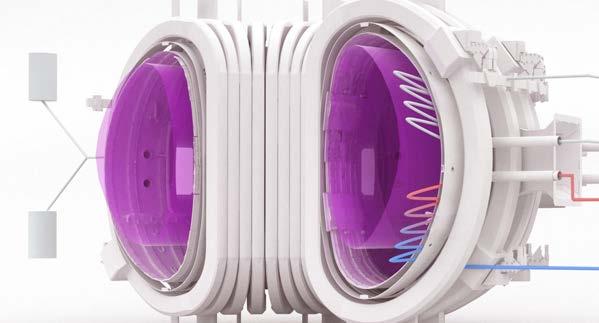
through a series of Technical Meetings, and, since 2012, through its regular DEMO Programme Workshops. These platforms foster discussion on physics and technology issues, facilitate the sharing of strategies for DEMO programmes and analyse potential courses of action. Over time, the topical emphasis has shifted from broad visions to the detailed technical challenges that must be overcome.
“By concentrating on identifying problems and discussing ongoing research and development, the IAEA Technical Meeting series and DEMO Programme Workshops enable the community to define requirements and analyse possible solutions in a collaborative manner. One example is the emergence of plasma control as a major issue for DEMO-type machines when long, or near continuous plasma operation is required,” said Surrey, who served as chair for the last three DEMO Programme Workshops, between 2016 and 2019.
Plans around the world
While various paths are still being explored to reach fusion-based electricity, the science and technology issues to be resolved are broadly agreed. Individual countries have different timelines, but the general consensus among scientists is that they can have an electricity-producing DEMO-type reactor built and operating by 2050.
In China, significant progress has been made in planning for the China Fusion Engineering Test Reactor (CFETR). This device will help bridge the gap between ITER and DEMOs. Construction of the CFETR will start in the 2020s and will be followed by construction of a DEMO in the 2030s.
In Europe, EUROfusion is responsible for developing the design of a DEMO. The project is currently in its conceptual design phase (2021–2027) and aims to demonstrate the technological and economic viability of fusion by producing several hundred MWs of net electricity. India has announced plans to begin building a device called SST-2 to qualify reactor concepts and components for a DEMO around 2027 and will then start construction of a DEMO in 2037.
The Japanese Joint Special Design Team for Fusion DEMO is currently working on the conceptual study of a steady state DEMO (JA DEMO), with construction planned to start around 2035.
In 2012, the Republic of Korea initiated a conceptual design study for ‘K-DEMO’, targeting construction by 2037, with the potential for electricity generation starting in 2050. In its first phase (2037–2050), K-DEMO will be used to develop and test components, and will then utilize these components. In its second phase, after 2050, it is hoped that it will demonstrate net electricity generation.
The Russian Federation is planning a fusion–fission hybrid facility called DEMO Fusion Neutron Source (DEMO-FNS), which will harvest fusion-produced neutrons to turn uranium into nuclear fuel and destroy radioactive waste. The DEMO-FNS is planned to be built by 2023 and is part of the country’s fast-track strategy to establishing a fusion power plant by 2050.
Fusion experts in the United States of America recently issued two reports that recommend starting a national research and technology programme, including public–private partnerships, to ultimately bring fusion to commercial viability. It aims to do this in the period 2035–2040, with the aim of positioning the country as a leader in fusion and speeding up its transition to low carbon energy by 2050.
In parallel, numerous privately funded commercial enterprises are also making strides in developing concepts for fusion power plants, drawing on the know-how generated over years of publicly funded research and development and proposing even more aggressive timelines. Artist’s concept of a fusion power plant converting the heat of fusion into heat and electricity.
(Source: EUROfusion)

Safety in fusion
An inherently safe process
By Carley Willis and Joanne Liou
While nuclear fission derives energy from splitting atomic nuclei, nuclear fusion does so by joining them, releasing energy in the process. Though both atomic reactions produce energy by modifying atoms, their fundamental differences have broad implications for safety.
The conditions required to start and maintain a fusion reaction make a fission-type accident or nuclear meltdown based on a chain reaction impossible. Nuclear fusion power plants will require out-of-this-world conditions — temperatures exceeding 100 million degrees Celsius to achieve high enough particle density for the reaction to take place. As fusion reactions can only take place under such extreme conditions, a ‘runaway’ chain reaction is impossible, explained Sehila González de Vicente, Nuclear Fusion Physicist at the IAEA.
Fusion reactions depend on the continuous input of fuel, and the process is highly sensitive to any variation in working conditions. Given that a fusion reaction could come to a halt within seconds, the process is inherently safe. “Fusion is a self-limiting process: if you cannot control the reaction, it stops by itself,” she added.
Furthermore, fusion does not produce highly radioactive, long lived nuclear waste. “Fusion produces only low level radioactive waste and does not pose any serious danger,” said González de Vicente. Contaminated items, such as protective clothing, cleaning supplies and even medical tubes or swabs, are short lived, low level radioactive waste that can be safely handled with basic precautions.
Most current experimental fusion devices use a mix of deuterium and tritium as fuel. Tritium is a radioactive isotope of hydrogen with a half-life of 12.3 years. As a result of the fusion reaction, neutrons are released, which impact and are absorbed by the wall surrounding the reactor core, said González de Vicente, making it radioactive. “The neutrons react with lithium contained in the wall, generating tritium that can then be reinjected into the machine.”
However, fusion and fission facilities do share some similarities, such as in how radioactive material is handled and how cooling systems are used. “Regulatory bodies have vast experience in the realm of safety and security for fission. We are working with them to ensure that all applicable knowledge is transferred to fusion,” González de Vicente said. “Not everything can be translated one-to-one, however, and the differences with fusion, such as the reduced amount and variety of radioactive material, the impossibility of core meltdown conditions and the lack of long lived waste, should be identified and addressed. The IAEA is helping to facilitate these efforts.”
International collaboration
ITER, the world’s largest fusion experiment has gathered experts from 35 countries to work towards making fusion energy sources a reality, while also helping to solve fusion’s safety and security challenges as the project develops.
A high degree of safety can be ensured by applying relevant safety requirements for fission, such as the IAEA safety standards, to fusion. For example, just as with nuclear fission reactors, proposed fusion plants must also consider dose regulations, and installations should be designed so that the minimum dose is ‘as low as reasonably achievable’, or ALARA. However, given the fundamental differences in the risk of accidents, the application of a graded approach is necessary to avoid overregulating the fusion process. “The problem with all existing safety standards is that they are geared towards fission,” said Stéphane Calpena, Deputy Head of the Safety & Quality Department at the ITER Organization. “We need to extract the standards that are relevant to fusion and apply them in a manner commensurate with risk to make sure that the technology is not only feasible, but that it is truly safe. Fusion is a
new way to create energy, and is still very much a young technology.”
The IAEA is helping to foster this technology by holding Technical Meetings for experts to share knowledge that can aid in overcoming challenges in fusion and ensure the safety of fusion facilities. The First Joint IAEA–ITER Technical Meeting on Safety and Radiation Protection for Fusion, chaired by Calpena in November 2020, focused on developing a methodology to determine the potential types and amounts of radioactive or hazardous material that could be released into the environment at fusion facilities, as well as on preparing publications equivalent to IAEA Safety Standards Series Nos SSR-4 and SSG-12 for fusion. The meeting covered topics such as risk criteria for, and the design and operation of fusion facilities. The Workshop on Waste Management for Fusion, scheduled for October 2021, will look at how radioactive waste from fusion energy production is classified and disposed of. One of ITER’s vacuum vessel sectors is installed — a 440-tonne piece that will help contain the device’s plasma.
(Photo: ITER)
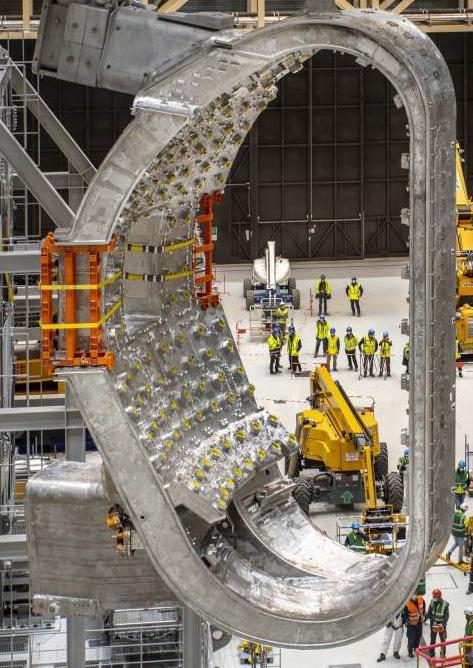
— Christian Hill, Head, IAEA’s Atomic and Molecular Data Unit
How IAEA databases help advance research towards the commercial use of fusion
By Aleksandra Peeva
The promise of harnessing nuclear fusion’s abundant energy potential through commercial fusion requires a better understanding of plasmas — superheated ionized gases — and the development of high-performance reactor materials. By supporting scientists studying plasma behaviour, and modelling the properties of materials used in fusion energy research, IAEA databases are helping to advance research towards eventual energy production on a commercial scale.
Central to developing fusion energy is achieving and then maintaining the extreme conditions needed for ‘fusion ignition’ — the point at which a fusion reaction is sustained by its own generated energy. This requires the reaction’s plasma fuels to be confined in a space for long enough to allow fusion to develop and heat itself to self-sufficiency.
Ignition also requires engineers to develop high-performance reactor wall materials able to withstand the steady flux of energy in the form of released heat and neutrons. This energy heats up the walls, and the neutron bombardment can lead to material damage — compromising the integrity of the wall material or causing the material to sputter back into the plasma and cool it.
A reactor’s materials should also absorb as little tritium — one of the hydrogen isotopes of the fusion’s fuel — as possible. Absorbed tritium fuel is lost fuel for the reaction. But more importantly, tritium is radioactive, and to minimize the amount and radiotoxicity of the eventual nuclear waste generated, the reactor’s walls should ideally not absorb tritium and become radioactive in the process.
Exploring plasma behaviour
A deep understanding of how plasma behaves in a reactor is necessary to increase the length of time it can be confined by magnetic forces. IAEA databases hold information on the processes occurring in core plasma and edge plasma, as well as in neutral beam injection systems used to heat the plasma towards ignition. They also contain data on the properties of various impurities that are deliberately injected into the plasma for diagnostic purposes and to mitigate instabilities.

The IAEA’s ALADDIN database is a searchable repository of evaluated collisional data for fusion-relevant processes. It is used by the research community to perform plasma diagnostics and learn about important plasma parameters, such as temperature and density. Using ALADDIN, scientists can better understand the collisional–radiative properties of ions that are critical for reliable plasma diagnostics.
Modelling materials for fusion
A lack of facilities that replicate the extreme conditions of a fusion reactor makes creating new materials for future fusion power plants complex. Using computational modelling techniques, high-performance computing platforms and analytical experimental characterization tools, experts are able to design materials that can perform well in a fusion energy environment.
Through modelling, new materials are being discovered and the reliability of existing materials can be predicted. This is especially important for the reactor’s innermost wall, which is located closest to the plasma in the reactor vessel and protects the vessel components from plasma-induced damage.
“The extreme environment of a nuclear fusion reactor’s first wall demands a careful choice of materials which must withstand high temperatures and particle bombardment without becoming eroded, brittle or radioactive, and without retaining the hydrogen fuel,” said Christian Hill, Head of the IAEA’s Atomic and Molecular Data Unit. “Only with reliable data from accurate computation and experiments can the relevant properties of candidate materials be predicted.”
Researchers use IAEA databases in fusion energy research and other plasma science and technology applications. Data are collected and evaluated by the IAEA through its networks, coordinated research projects and Technical Meetings, and distributed through its free, searchable and curated online databases.
“The value in a curated, international database is in its role as a permanent, trusted and accessible repository of evaluated data that can be freely used by the fusion community. The IAEA’s Atomic and Molecular Data Unit is unique in other ways, too: it has existed for more than 40 years, which is pretty old in ‘fusion-data years’,” said Hill.
The IAEA’s databases are continuously improved and expanded based on the specific data needs of researchers, including the quantification and implication of uncertainties in data, and techniques for data validation, curation and dissemination.
All fusion-related databases maintained by the IAEA can be accessed at: amdis.iaea.org/databases A visualization of the cascade of collisions leading to damage in a crystalline material.
(Image: courtesy of Andrea Sand/ Aalto University)
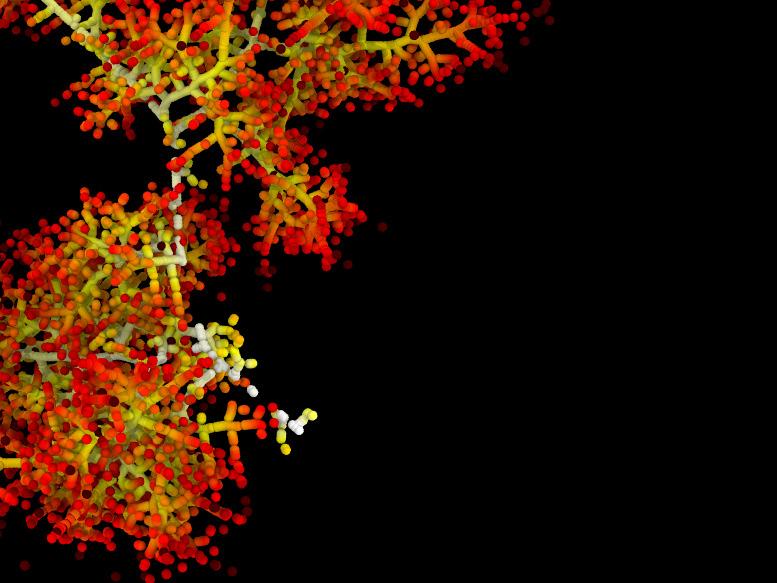
— Alberto Loarte, Head of the Science Division, ITER Organization
Burning plasma
A critical stepping stone towards fusion power
By Matteo Barbarino
In our sun’s core, extreme temperatures and the immense pressure created by massive gravitational forces create ideal conditions for nuclear fusion.
Recreating that on earth, however, without the extreme gravitational forces of a star, and by means of a fusion reactor, poses many technical challenges. The biggest of these is keeping the heated fusion plasma — a charged gas composed of ions and free electrons in which the reaction takes place — at over 100 million degrees Celsius, confining its particles in a magnetic field and holding them together long enough for reactions to take place and produce energy.
Understanding and validating current hypotheses of how this hot fusion plasma behaves are among the key issues fusion scientists and engineers must address to eventually produce electricity from fusion.
A super fuel for temperatures hotter than the sun
Fuel options for fusion are limited. The fuel with the highest performance potential on earth is made from a mixture of deuterium and tritium ions — two heavier forms of hydrogen. When colliding under extreme temperatures, deuterium and tritium fuse to generate charged particles with two protons and two neutrons, known as alpha particles, as well as free neutrons. While the neutrons escape the magnetic field and do not interact with the plasma, the alpha particles are confined by the magnetic field and further heat the surrounding plasma. “Controlling this heating is critical to harnessing fusion power,” said Matthew Hole, Professor at the Australian National University.
Safe and sustainable fusion power relies on these charged alpha particles and their energy to maintain the plasma at a constant temperature, thus allowing the reactions to be self-sustaining. Achieving this is essential to operating a fusion reactor.
In the 1990s, experimental fusion reactors produced up to 16 megawatts (MW) of power for a little less than a second. In those experiments, the alpha particles provided only about ten per cent of the heat externally supplied. Understanding what happens when alpha particles provide more of the heat will be explored through initiatives like ITER — an international reactor-scale experiment under construction in France (see article, page 10).
“ITER will provide us with the opportunity to study ‘burning plasmas’ in which at least 66 per cent of the total heating will come from fusion alpha particles. In these conditions, ITER will produce 500 MW of fusion power for up to 500 seconds,” said Alberto Loarte, Head of the Science Division at the ITER Organization. He said his organization’s experiments will provide much-needed answers to key questions in burning plasma physics, such as how to create a plasma that is self-sustained by the internal heating from its alpha particles, and how to find optimal operating conditions for high fusion performance that are compatible with the power handling capabilities of the reactor wall.

How to make plasma self-sustaining
An important indicator of a fusion reactor’s performance is its ‘fusion power gain’, which is determined by the plasma’s temperature, density, and energy confinement time — a measure of how effectively the magnetic field maintains the plasma energy over time. Creating a self-sustaining reaction requires three conditions: a temperature of about 100 million degrees Celsius; a density that is one million times less that of air; and the energy confinement time of just a few seconds.
Although the conditions required are well understood, how they can be reached simultaneously is far from obvious. For example, increasing the plasma density is advantageous in principle, as it increases the likelihood of fusion reactions. However, as the density approaches its maximum, many experiments show that plasma confinement degrades more than expected, says Richard Hawryluk, Associate Director for Fusion at the Princeton Plasma Physics Laboratory in the United States of America.
For the ITER experiment to succeed, solutions to these problems need to be found, and much of the research to do so requires international cooperation. Through its series of Technical Meetings on energetic particle physics, plasma control, and fusion data acquisition, validation and analysis, the IAEA provides a platform for the exchange of scientific and technical results, and is helping to develop modelling tools that can be used to predict the behaviour of fusion plasma in ITER and future fusion power reactors.
Finding the ‘sweet spot’
One of the greatest challenges is finding optimal operating conditions with maximum fusion power and plasma control that would allow for high performance without breaching operational boundaries for long periods. Breaching operational boundaries is problematic as it could lead to instabilities that can terminate the plasma in a phenomenon known as plasma disruption.
“In a torus-shaped tokamak type reactor, like ITER, a disruption could rapidly terminate the plasma over a few milliseconds and generate substantial thermal and mechanical stress to the reactor’s components,” said Michael Lehnen, Scientific Coordinator for ITER Organization’s Stability & Control Section. “The IAEA is helping to avoid this scenario by fostering information exchange on experimental, theoretical and modelling work in this area, with special emphasis in the next few years on developing a solid basis for the design of ITER’s disruption mitigation system.”
Recent experiments and modelling efforts incorporating artificial intelligencebased methods are shedding light on the requirements for effective plasma control — helping to pave the way for the safe design and operation of future fusion power plants. “Powerful advanced statistics and machine learning approaches applied to disruption research can help identify significant patterns and reveal hidden information in years’ worth of experimental data,” said Cristina Rea, Research Scientist at the Massachusetts Institute of Technology (MIT) Plasma Science and Fusion Center.
A productive synergy among control physicists, modellers, scenario developers and data engineers is emerging, where new solutions are being designed to avoid these disruptive boundaries. More work must be done to evaluate the applicability of these data-driven methodologies for projects such as ITER, but the results thus far are encouraging, Rea said. A visualization of high energy particles, in the form of plasma, flowing through a tokamak-type reactor.
(Photo: Shutterstock)

The ‘He Ion Source and DiFU Dual-Beam Facility’ was installed with IAEA support in Croatia’s Ruđer Bošković Institute.
(Photo: IAEA)
Closing fusion’s materials and technology gaps
By Matteo Barbarino
The most challenging science and engineering endeavour on earth is arguably fusion. Building a fusion reactor, achieving a self-sustaining reaction and converting that power to near inexhaustible electricity will change humanity and our relationship with energy forever. As enticing as this may sound, progress has not been easy or smooth. Technical challenges around the structures, fuels and materials needed to hold such complex machines together remain only partially solved.
Understanding the technical limits and gaps of knowledge faced by fusion energy today begins by looking inside the reactor itself.
Inside a tokamak reactor (see article, page 6), a super-hot ionized gas or ‘plasma’ is heated to over 100 million degrees Celsius (°C) to induce fusion reactions. Confined by powerful magnetic fields, the walls of the reactor are protected from the volatile plasma.
Plasma used in nuclear fusion is usually made up of two heavy isotopes of hydrogen — deuterium and tritium — which then fuse to produce helium and neutrons. In fusion power plants, engineers hope to ‘breed’ or create additional tritium from the reaction itself with yet untested lithium blanket shielding that reacts neutrons resulting from fusion. “The energy of the fusion-generated neutrons poses serious challenges to the fusion power plant’s first wall and vacuum vessel, which means considerations need to be given to radiation damage, biological shielding, remote handling, and safety,” explained Ian Chapman, CEO of the United Kingdom Atomic Energy Authority.
Chief among engineers’ tasks is developing high-performance materials that are able to sustain high temperatures and the intense neutron fluxes from the reaction. Understanding the impact of operating conditions on the plasma-facing components is also essential for the future of large-scale fusion power plants.
Materials built for extremes
Creating structural and plasma-facing materials that can withstand degradation from neutrons is a priority for researchers. These materials need safety characteristics such as low neutron-induced radioactivity to minimize the production of radioactive waste. Today, however, there is a lack of specialized fusion irradiation facilities where radiation degradation mechanisms can be tested and materials can be developed and qualified under the necessary conditions.
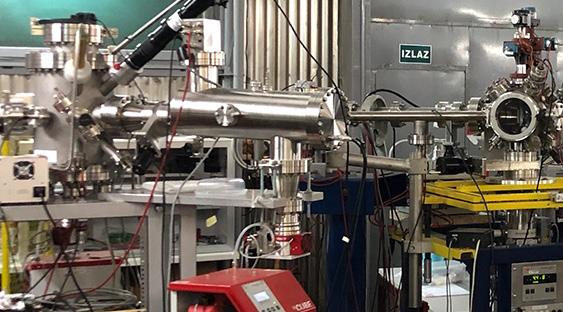
The IAEA is helping to address issues associated with fusion materials development and research by coordinating the drafting of guidelines for reference material testing techniques, and by bridging knowledge gaps in designing facilities for testing fusion reactor materials and components.
“Technologies like the dual-beam ion facility installed in 2019 at the Ruđer Bošković Institute in Croatia with IAEA support can simulate the conditions that a material would be exposed to in a fusion reactor. These conditions include product transmutation and simulating damage produced by energetic fusion-generated neutrons and particles,” said Melissa Denecke, Director of the IAEA’s Division of Physical and Chemical Sciences.
The main part of a reactor where plasma comes into direct contact with the reactor vessel is known as the ‘divertor’, and scientists and engineers are looking to find its optimal configuration so that it better handles the heat fluxes it encounters. Using knowledge and data acquired from various irradiation experiments and simulation tools, they are also developing and verifying a framework of reactor design criteria for all in-vessel components, divertors included.
A very hot exhaust
Located at the very bottom of a reactor in most designs, where impurities such as helium ‘ash’ are diverted, the divertor acts as the ‘exhaust pipe’ of the fusion reactor and is where any excessive heat is channelled to. This configuration helps to produce ‘purer’ plasmas with better energy confinement — a critical parameter for the performance of a fusion device — ensuring the plasma is hot enough for long enough so that sustained fusion reactions can take place.
In ITER, the world’s largest fusion experiment, the divertor will be made up of 54 ‘cassettes’, each weighing 10 tonnes. The conditions placed on the cassettes will be very demanding; facing steady heat fluxes of 10 to 20 megawatts per square metre, with parts exposed to temperatures of between 1000°C and 2000°C, the cassettes will need to be replaced by remote handling at least once during the machine’s lifetime. To deal with the extreme heat and damaging particles, the components facing the plasma will be armoured with tungsten, a material that has both low tritium absorption and the highest melting temperature of any natural element.
“Although ITER’s divertor design reflects the state of the art of our current understanding and capabilities from a physics and technology point of view, further developments will be required for future fusion power plants. Learning what these are is one of the many important missions of the ITER project,” said Richard Pitts, Leader of the Experiments & Plasma Operation Section at the ITER Organization.
Designing and building future fusion reactors will depend on the technical, technological and material results of ITER and other well-established multinational coordinated research and development activities, but the distance between us and a fusion-powered future continues to narrow every day.

Uniting countries through fusion research and cooperation
By Elodie Broussard
“Shoot for the moon. Even if you miss, you’ll land among the stars,” author Norman Vincent Peale once said. When it comes to nuclear fusion, scientists are shooting for the stars, as they seek to discover whether it is possible to generate fusion electricity on an industrial scale here on earth.
Globally, experts from around 50 countries are involved in research in plasma physics and nuclear fusion technology development. Many of these countries are working to intensify their fusion research programmes in the face of a rapidly growing energy demand and accelerated climate change from the burning of fossil fuels.
To facilitate ongoing international efforts, the IAEA offers its Member States a range of research and capacity building activities, — sometimes at the regional level — helping to bridge the gaps in fusion knowledge and experience between countries.
Over the past 50 years, the IAEA has supported fusion research and development worldwide by organizing a variety of fusionrelated forums, including the biennial International Fusion Energy Conference. The IAEA also organizes a series of workshops on demonstration fusion power plant concepts, a series of Technical Meetings on topics relevant to fusion science and technology, and coordinate research activities through which it brings together institutions and scientists to address key issues of common interest.
Through its publications on fusion, such as the Nuclear Fusion journal and other series, the IAEA disseminates knowledge and information and helps facilitate the spread of advanced knowledge in the scientific community. In addition to maintaining a fusion portal and a database of fusion devices, the IAEA has established numerical data libraries of fundamental molecular and nuclear data that are indispensable for fusion research and technology development. Collaborating with many partners, the IAEA also organizes and supports education and training activities on fusion, including international and regional schools and workshops.
New to the global fusion scene, Costa Rica receives IAEA support to bridge its gaps with other countries through technical development and capacity building. In 2019, a workshop organized by the Technology Institute of Costa Rica with IAEA support offered participants from Latin American countries an
Over 100 fusion devices (public and private) are currently in operation, under construction or being planned.
(Source: IAEA Fusion Device Information System).
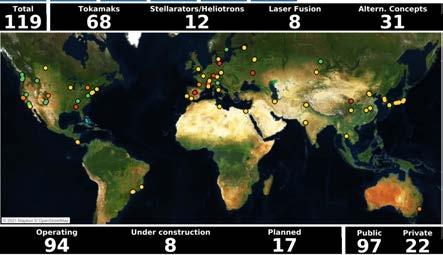

opportunity to take part in joint experiments and receive training in operating the two small fusion devices hosted at the institute.
Strengthening the links between fusion leaders and contributing countries
Six countries and the European Union, through Euratom, are cooperating in the world’s largest fusion experiment, ITER, an experimental fusion reactor under construction in France (see article, page 10).
“For countries which are not part of the ITER project, the IAEA performs an important bridging function, disseminating knowledge from ITER to the wider community and vice versa. It does so via Technical Meetings, workshops, schools and e-learning materials, all including the contribution of ITER experts,” said Danas Ridikas, Head of IAEA’s Physics Section.
Inspiring a new generation in Southeast Asia
Since 2014, the Association of Southeast Asian Nations (ASEAN) School on Plasma and Nuclear Fusion has been one of the key activities towards initiating a fusion programme in Thailand and advancing fusion research in the region. In January 2020, the IAEA and ITER supported the school in promoting interaction between young talent and international leading researchers. “The IAEA provided experts who shared knowledge and experience and greatly inspired the young generation,” said Kanchalika Dechates, Head of International Cooperation at the Thailand Institute of Nuclear Technology (TINT). More than 80 young researchers from the region participated in the school.
To strengthen training and collaboration between research teams in developed and developing countries, since 2004 the IAEA has led a coordinated research project on small and medium size fusion devices that brings together researchers from 19 countries. “This project represents an opportunity for Thai researchers to meet and work collaboratively with lots of experts worldwide,” said Boonyarit Chatthong, Assistant Professor at the Prince of Songkla University in Thailand.
This long-standing partnership makes it possible to perform joint and comparative experiments, train personnel across institutions and countries, and educate a new generation of fusion scientists in cutting-edge theories and techniques. “As Thailand will have its first ever fusion device in the near future, this project will enable us to start our own fusion programme,” said Chatthong.
The construction of an experimental tokamak (see article, page 6) in Thailand is the central activity in the country’s fusion development programme. It will be the first fusion device operated by ASEAN and a crucial learning platform for Thai and ASEAN researchers.
In 2018, the IAEA allocated grants for Thai scientists and engineers to attend the IAEA Fusion Energy Conference, which took place in India. That year, a Thai researcher also joined the Joint ICTP–IAEA College on Plasma Physics in Italy, which gathered about 70 advanced PhD students, post-doctoral researchers and other young researchers from 23 countries, fostering international collaboration. Donated to Thailand in 2018, the HT-6M tokamak is a main pillar of the country’s fusion roadmap.
(Photo: ASIPP, China)
— Boonyarit Chatthong, Assistant Professor, Prince of Songkla University, Thailand
Fusion: Ready when society needs it
By Michael Amdi Madsen
Scientists have been touting the potential of fusion energy since the 1920s, but until very recently commercial fusion had remained a distant dream. To better understand why, after decades of research, fusion is still not a part of the global energy mix, and why that is set to change, we spoke to Melanie Windridge, UK Director of the Fusion Industry Association, Communications Consultant for Tokamak Energy, and founder of Fusion Energy Insights.
Q: There’s an old joke that ‘nuclear fusion is the technology that is always 30 years away’ — is this true?
A: While that’s a classic fusion joke, it’s a bit sad because, in reality, progress is being made. Today, factors are coming together to accelerate advances in fusion. For one, the science has matured — we now have a good understanding of plasma physics, and concepts like tokamaks have achieved fusion reactions. On top of that, new technologies have come along like high-performance computing to improve plasma simulations and modelling; artificial intelligence and machine learning to optimize and control operations; and high-temperature superconductors that can produce much stronger magnetic fields to better confine fusion fuels. Today’s much more powerful and efficient lasers could boost inertial confinement fusion, and advances in manufacturing could help to bring down the costs of experiments and future power stations.
Importantly, there is now a greater appetite from the public for climate solutions, and governments are setting zero-emissions targets. There is also the fusion private sector, which to-date has attracted around US $2 billion in investment. The Fusion Industry Association has now grown to about 25 members, and even oil and gas companies are starting to show interest in fusion.
Q: To address climate change, many countries are aiming for large-scale decarbonization by 2030 and carbon neutrality by 2050. Will fusion come too late to make a difference?
A: The Russian physicist Lev Artsimovich once said, “Fusion will be ready when society needs it.” I think that’s true. Ideally, we would have solved fusion 30 years ago and today it would be ready to roll out. But conditions in “Even if fusion isn’t online in time to contribute to the 2050 targets, it will be needed in the second half of the century when energy demand will be even greater.”
— Melanie Windridge, UK Director, Fusion Industry Association
the past weren’t right for fusion, and there wasn’t the right kind of drive or possibility for it.
So even if fusion isn’t online in time to contribute to the 2050 targets, it will be needed in the second half of the century when energy demand will be even greater. But we need to push hard now, with the aim of getting fusion on the grid before 2050.
Q: What barriers do you think could hold the technology back and how can they be avoided?
A: There is a variety of challenges we must overcome, and they come at different stages. The first is getting more energy out of a fusion reaction than we put in. We call that milestone ‘breakeven’. After exceeding the breakeven point, we need to build a pilot plant that can generate electricity. Once that’s a success, we can plan for a commercial rollout.
Between breakeven and first electricity there are technical barriers, such as how to extract the energy and breed more tritium fuel. Fusion’s environment is also demanding in terms of materials. It requires extreme heat and cold if you’re using superconducting magnets, as well as strong magnetic fields. The energetic neutrons are the most problematic though, as they can be very damaging to materials. It’s thus very likely that we’ll have to replace certain components of power stations from time to time, so we need to engineer a machine in which that can be done quickly, easily and economically.
Beyond physics and engineering, the fusion community also needs to talk to governments about regulation so that, when we’re ready to build, there won’t be licensing roadblocks. Finally, there is the element of public acceptance and ensuring that people are on board with developing fusion too. We need to think about all of these issues and start talking about them now. And, actually, we are.
Q: Today, almost 800 million people live without reliable electricity access. Is nuclear fusion a solution for these people and what is the sector doing to involve developing countries?
A: When the international fusion project, ITER, was first conceived in that famous Reagan-Gorbachev fireside meeting in Geneva, 1985, they said they wanted fusion for all of humankind, and that’s still the goal. ITER is planning an educational programme that’s open to all countries, with the aim of building the future fusion workforce. This will be important if we are planning on rolling out fusion around the world.
Public–private collaboration is now starting to come into place that will help reduce costs and share risks. In developing countries this public–private cooperation will be particularly important and will likely require intergovernmental assistance.
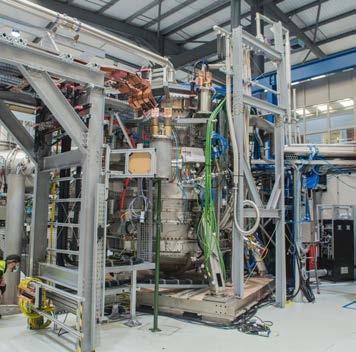
Q: Physics and nuclear are fields typically dominated by men. What’s being done in fusion to ensure a more gender-balanced industry?
The ST40 tokamak, built and operated by private company Tokamak Energy.
(Photo: Tokamak Energy)
A: People have been aware of the gender imbalance in physics and fusion for a long time, and there have been initiatives to change it, but it’s going to be a slow, multigenerational process.
For almost 20 years now, I’ve been involved in initiatives aimed at trying to change gender perceptions. In some of the big labs, they are actively trying to address the gender issue through programmes aimed at improving diversity and creating networks to increase inclusivity. For private companies, which tend to be very small, it’s more challenging.
It’s not just what labs can do, though, but also what we can do as individuals. I recently started @womeninfusion on Instagram, to show women working in the field and help encourage the next generation of girls to pursue physics.
Simon Woodruff is the founder and president of Woodruff Scientific, a US company that under contract to private and public institutions, researches and develops fusion technology to accelerate the development of economic fusion energy. Active in the fusion community, Woodruff hosts an annual Scientific Computing Bootcamp for undergraduates, has organized national workshops in fusion energy sciences, and is a current participant in two IAEA initiatives on compact fusion neutron sources and private fusion development.
Moonshots and sure shots
Why fusion needs enterprises and start-ups
By Simon Woodruff
The basic premise of private fusion development is that there are many paths to commercialization, and entrepreneurs can complement government programmes. We only have to look to the space launch industry to illustrate that point. A combination of clever public–private partnership programmes run by the US Government has led to cost savings across the board in space launch. SpaceX, Blue Origin and others have shown how this can be done.
Private ‘fusioneers’ think similarly, and ask: how can we make things less expensive? How can we use the latest innovations in materials, technology and artificial intelligence to reach viability? How can we reduce total capital costs and cost of electricity so that fusion systems can compete with combined cycle natural gas?
I’ve been following the story of private fusion enterprises very closely since my postdoc at Lawrence Livermore National Laboratory in 1999. The US Department of Energy ran a small programme called Innovative Confinement Concepts (ICC), which sought simpler and easier-to-engineer concepts for nuclear fusion. I helped to organize the ICC workshop series and there was a healthy overlap with fusion concepts being developed privately. Just down the road from Livermore, TAE Technologies, then called Tri-Alpha Energy, was setting up and getting going; up the road in Vancouver, Canada, General Fusion was starting up, and in the United Kingdom, Tokamak Energy, then called Tokamak Solutions, was being founded too.
I stepped out of Lawrence Livermore in 2004 to follow their lead and see if we could really expedite the delivery of fusion energy systems into the commercial market space. In the 22 years since then, these fusion ‘moonshots’ have collectively raised over US $1.5 billion to pursue their concepts, and a burgeoning fusion industry has sprung up to support these efforts.
Private fusion enterprises are optimistic — often giddily so. It is the intersection of

entrepreneurship and advanced technology that has earned them almost cult status among CTOs and CEOs from other industries. But there’s ubiquitous hope, it has to be said. Many private fusioneers started out in government programmes with 20+ year development horizons but are now engaged in discussions of ‘cash neutrality’ and bootstrapping efforts in a ‘scrappy’ startup ecosystem. They’re supported in part by Advanced Research Projects AgencyEnergy’s efforts to straddle the chasm between conventional lab work and industry, through a series of small programmes like ALPHA, BETA, GAMOW and OPEN, with more to come, I imagine.
Tech to Market (T2M) is now also a thing for fusion. There’s regular discussion of ‘exits’: does the startup get bought out, does it go to market, does it sell intellectual property? Can we do it before the investment fund lifetime expires?
Since leaving Lawrence Livermore, I have had the privilege of carving out a career working with private fusion enterprises, from a sonofusion startup in Grass Valley, California to an MIT spin-out, raising a staggering US $200 million in a Series A investment. Clearly there is renewed interest in both carbon and cash neutrality. Each entrepreneur and enterprise has a different technical approach (universally, smaller is better, however) and has a slightly different idea about their commercialization plan — some are keen on the moonshot approach, where all effort is focused on being first to market with something to generate power. But the moonshots (perhaps 20 in total worldwide) make up only a tiny fraction of the small business ecosystem that offers products and services supporting fusion.
In the USA, there is a Small Business Innovation Research grant programme supporting hundreds of companies doing things relating to fusion; whether that’s making ignitrons or capacitors, performing simulations, developing novel materials for additive manufacturing, or examining novel diagnostic techniques. Small businesses have lower overheads than the big labs. They are nimble and can pivot — offering one line of products one year and coming up with a different set of solutions the next. They are also innovative, keeping in mind the most important problems and finding solutions, and focusing on what might ultimately enable fusion energy to enter the marketplace.
In summary, the present of fusion contains fusion startups and small businesses. The future is bright for small! A rendering of high energy particles flowing through a tokamak reactor.
(Image: Shutterstock)

Safe to drink: IAEA-supported water treatment unit to make water from aquifers potable in Jordan
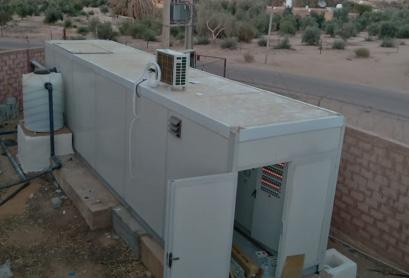
Completed in December 2020, the water treatment unit facilitates the use of older, sandstone groundwater aquifers.
(Photo: A. Al-Sayaheen/WAJ)
In Jordan, where water scarcity is a matter of growing concern, a new groundwater treatment unit, developed with the support of the IAEA, will soon begin pumping high-quality drinking water to thousands of homes in Aqaba Governorate at the country’s southern tip. The first of its kind in Jordan, the pilot treatment system works by removing naturally occurring radionuclides from groundwater, allowing the Water Authority of Jordan (WAJ) to leverage previously unused aquifers and reduce stress on existing sources of water.
Jordan is among the ten countries with the lowest availability of fresh water per capita in the world due to its semiarid climate, characterized by low precipitation rates and the result of its growing population. This situation is expected to worsen and, according to the World Health Organization’s Regional Office for the Eastern Mediterranean (EMRO), Jordan will enter a state of ‘extreme water poverty’ by 2025 unless effective measures are taken. One such measure is the exploitation of deeper, older groundwater resources, such as the Ram Aquifer, which is surrounded by sandstone and holds vast amounts of highquality fresh water unlikely to show any anthropogenic contamination. However, sandstone tends to contain elevated concentrations of naturally occurring radionuclides, mainly radium, which can be dangerous to consumers of the water.
Supported by the IAEA’s technical cooperation programme, isotope analysis and waste technology specialists have helped experts in Jordan to measure and monitor the concentration of radium in groundwater sampled from the Ram Aquifer and to explore a number of options for the water’s treatment.
Results from the analysis of the water prompted the construction and installation of a water treatment unit, located near a water well. The treatment unit filters the water by adding hydrous manganese oxide and subsequently channelling the water through a series of ceramic filters, reducing radionuclide concentrations to levels that conform with Jordanian standards.
Following the arrival of the first basic components, such as pumps and gauging devices, assembly of the water treatment equipment was initiated in February 2020, with civil works and construction beginning the following month. By December 2020, the treatment unit was complete and ready to be used by Aqaba Water Company, the local water distribution authority. The new unit can treat 40 cubic metres of water per hour — or 12.5 litres per second — providing enough water for approximately 2000 people.
“We are planning to establish more units to treat water resources in the city of Aqaba, as well as in new groundwater wells in the southern region of Amman Governorate, in an area called Khan Alzabib,” said Amal Al-Sayaheen, Director of Research and Technical Services at the WAJ.
All materials in the earth’s crust contain naturally occurring radionuclides. They are dispersed throughout rocks and soils, normally in low activity concentrations. However, they can leach into groundwater and, as a result, into drinking water derived from groundwater sources and springs. “The presence of radionuclides may warrant careful analysis to understand the radiological risks associated with the consumption of these waters,” said Horst Monken-Fernandes, an IAEA Environmental Remediation Specialist assisting Jordan in this project.
Radioactivity in drinking water is an issue in many countries in the world. Recently, the IAEA organized a workshop in the scope of the International Conference on the
Management of Naturally Occurring Radioactive Material (NORM) in Industry, entitled Groundwater 360o , which explored various aspects related to the presence of natural radionuclides in groundwater.
THE SCIENCE
The quality of groundwater from sandstone basins in the Middle East is mostly high. However, due to its composition, sandstone tends to contain elevated activity concentrations of naturally occurring radionuclides. In the case of Jordan, the levels of naturally occurring radium in these basins, and the carcinogenic properties of such radionuclides, may impair the quality of the country’s groundwater.
Radium can be removed from the water, however, by using a filter composed of a silicon carbide membrane that supports a layer of hydrous manganese oxide (HMO).
As water passes through the filter, the HMO absorbs the radium. After a designated length of time, the ceramic filter is ‘backwashed’ and the HMO containing the absorbed radium is disposed of as waste.
— By Omar Yusuf
Improved soil and nutrient management practices increase rice yields in the Lao People’s Democratic Republic

Rice demonstration trial on a farmer’s field.
(Photo: M. Zaman/IAEA)
Rice, the main staple crop in the Lao People’s Democratic Republic (PDR), is key to food security and employment. Over 80 per cent of the country’s farmers grow rice, which takes up about 60 per cent of the cultivated area in the country. However, the country’s mountainous topography, tropical climate with frequent monsoons, soil erosion, lack of suitable rice varieties and insufficient use of fertilizers have limited rice yields, threatening livelihoods in this agrarian society. Since 72 per cent of the rice-growing area in the country is dependent on natural rainfall, increasingly variable rainfall patterns owing to a changing climate are predicted to have a devastating impact on rice production.
The IAEA, in cooperation with the Food and Agriculture Organization of the United Nations (FAO), has supported farmers in Lao PDR in increasing rice yields by 60 per cent through better soil and nutrient management practices identified using nuclear techniques (see The Science box). Trials conducted on farmers’ fields have shown that by applying chemical fertilizers and manure in an optimized way, rice yields have increased from 3.16 to 5.1 tonnes per hectare. “I have been applying these practices for three years now,” said Somphet Siphandone, a farmer in Sanakarm district, Vientiane province, who is involved in a pilot project putting these findings into practice. “My yield has increased 60 per cent compared to our traditional practice. We were introduced to efficient and effective agricultural techniques through the training provided, and they performed well in our fields. Thanks to the programme, we are more resistant to the changing climate and we are harvesting more.”
The IAEA, through its technical cooperation programme, has trained researchers in using nitrogen-15, a stable isotope of nitrogen, to quantify the amount of nitrogen that plants take up from fertilizers, and then determine the precise amount of fertilizer that farmers should use at various stages of the crop’s life, as well as how best to incorporate locally available rice straw and animal manure into these fertilizers as a source of nutrients.
Based on those results, IAEA and FAO experts helped local specialists develop a set of rice production guidelines for farmers and the agriculture officers working with them. These guidelines provide best practices for soil and nutrient management and are based on results obtained with the use of isotopic techniques.

Graph showing increase in rice yield by using improved soil and nutrient practices.
To reach more farmers and disseminate these best practices, the IAEA and the experts from the National Agriculture and Forestry Research Institute (NAFRI) developed an easy-to-use brochure for farmers in the Laotian language, using information contained in the rice production guidelines. So far, 57 farmers from four villages in Vientiane province have been trained in the pilot phase of the programme. “The brochure is a complete technological toolbox that shows farmers exactly what to do, from preparing the land for sowing to applying fertilizer, managing weeds and insects, and ensuring a timely harvest,” said Mohammad Zaman, a soil scientist and plant nutritionist for the Joint FAO/IAEA Programme of Nuclear Techniques in Food and Agriculture.
THE SCIENCE
Stable isotope techniques
Isotopes are atoms of the same element with the same number of protons, but a different number of neutrons, and thus a different atomic weight. For example, nitrogen-15 has the same chemical behaviour as nitrogen-14, but has one more neutron, making it heavier. Scientists can use fertilizers labelled with this isotope to understand how nitrogen in fertilizer transforms soil, plant and water systems, tracking and determining how effectively it is taken up by the crops and how much is left over in the soil.
Scientists can also use isotopes to trace the movement and origin of various emissions in agriculture: using nitrogen-15 to track nitrous oxide and carbon-13 to track methane and carbon dioxide.
— By Lu Han
New drone technology now available for radiological monitoring in emergency situations
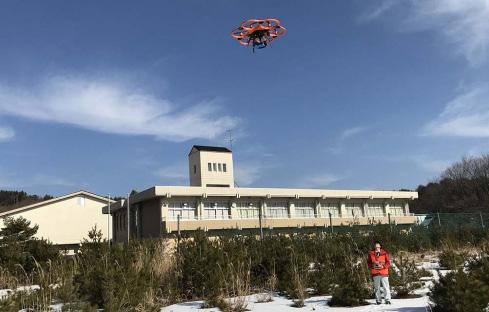
A new technology using drones, developed by the IAEA for use by the authorities of Fukushima Prefecture in Japan, allows for radiological measurements in contaminated areas.
(Photo: Fukushima Prefecture) In the aftermath of a nuclear accident, such as the one at Fukushima Daiichi nuclear power plant in 2011, the radiologically contaminated area in the vicinity of a reactor can be too dangerous for people to enter to monitor radiation. A new technology using drones, developed by the IAEA for use by the authorities of Fukushima Prefecture in Japan, will make this task easier.
The IAEA-developed methodology and instrumentation for unmanned aerial vehicles (UAVs) equipped with radiation detectors, cameras and GPS devices have been tested and validated under real conditions in Fukushima Prefecture and are now available for practical use in routine or emergency situations. Based on this experience, the IAEA is ready to assist interested Member States in developing and

Full 3D aerial photogrammetry superimposed with a radiological map obtained using a single UAV in two consecutive flights.
(Image: IAEA and Fukushima Prefecture)
implementing this technology for radiological mapping following a nuclear or radiological emergency.
The low cost of drones and the avoidance of human exposure to radiation are two significant advantages of this technology.
The IAEA and Fukushima Prefecture first started working together on developing and using UAVs for radiological monitoring in 2012. In the framework of the IAEA Action Plan on Nuclear Safety, the IAEA has assisted Fukushima Prefecture through two consecutive projects from 2012 to 2020 by: • Providing a complete UAV-based instrumentation system for radiation measurements — a radiation detection system with data processing and storage capabilities — developed and built at the IAEA’s
Nuclear Science and Instrumentation
Laboratory (NSIL); • Providing post-measurement analysis and interpretation methodology as well as training personnel both in
Fukushima Prefecture and at NSIL in
Seibersdorf, Austria on how to apply the UAV and its instrumentation system as well as on how to use the software for obtaining and interpreting data.
Recently, there have been breakthrough advances in UAV technology, and major developments are expected in the near future, including larger payloads, integrated detectors and sensors, improved self-navigation and the ability for the vehicles to work in cooperation with other UAVs as well as ground systems. The IAEA is currently working on the integration and testing of new, improved instrumentation, including its adaptation for the next generation of UAVs.
“These novel developments will both extend the flight time of a UAV and allow dose equivalent rates and gamma spectra to be determined with a single measurement,” said Danas Ridikas, Head of the IAEA’s Physics Section. “When combined with highquality camera capabilities, the new system will allow users to obtain a full 3D aerial photogrammetry model superimposed with radiological maps and radionuclide identification.”
UAV-based technologies will be crucial for advancing radiation monitoring, including enhancing the application of environmental mapping and improving the long-term monitoring of contaminated areas, explained Miroslav Pinak, Head of the IAEA’s Radiation Safety and Monitoring Section.
The data collected using the UAV systems developed by the IAEA and validated by Fukushima Prefecture can be used to assess potential radiation risks and help establish appropriate remediation, decontamination and nuclear waste management plans and strategies in Japan.
A detailed IAEA technical document on the project results, including instrumentation calibration, methodology validation, in-situ dose rate measurements and mapping of the temporary storage sites for radioactive waste in Fukushima Prefecture will be made available publicly.
The technology, methodology and related training opportunities are available to IAEA Member States upon request and are already being implemented in some countries with the Agency’s support.
How does the technology work?
The UAVs are equipped with radiation detectors, cameras and GPS devices. After a UAV takes off, radiation readings and other relevant information are synchronized with its exact GPS position and sent in real time to the pilot at the ground station, while also being stored onboard. After landing, all of the detailed data is recovered, and the photographic and geographic information is reconstructed together with the corrected radiation measurements. The satellite-like photographs and the analysed radiation measurements are then made available to decision makers for further action.
— By Alexandra Peeva
Volume 61 Number 4 April 2021 Co-published and edited by the International Atomic Energy Agency and IOP Publishing
Online: iopscience.org/nf
International Atomic Energy Agency, Vienna is the acknowledged world-leading journal specializing in fusion. The journal covers all aspects of research, theoretical and practical, relevant to controlled thermonuclear fusion. Launched in 1960, the journal publishes around 400 new articles a year and offers a high-quality, impartial forum for the sharing of knowledge within the fusion research community. The IAEA manages the peer review process and coordinates with authors and referees ,as well as with the journal’s Academic Editor, its Board and its co-publisher, IOP Publishing. In recent years, the journal content has also reflected the increasing focus on materials used in fusion machines. There are half a million full text downloads from the electronic journal each year, and it consistently achieves the highest impact of all comparable journals. Journal; doi:10.1088/issn.0029-5515; Online ISSN: 1741-4326; Print ISSN: 0029-5515
IAEA-TECDOC-1851
Integrated Approach to Safety Classification of Mechanical Components for Fusion Applications IAEA TECDOC SERIES
IAEA-TECDOC-1851
IAEA-TECDOC-1851
Integrated Approach to Safety Classification of Mechanical Components for Fusion Applications
Fusion Physics
is a comprehensive reference for graduate students and an invaluable guide for more experienced researchers. It provides an introduction to nuclear fusion and its status and prospects, and features specialized chapters written by leaders in the field, presenting the main research and development concepts in fusion physics. It starts with an introduction to the case for the development of fusion as an energy source. Magnetic and inertial confinement are addressed. Dedicated chapters focus on the physics of confinement, the equilibrium and stability of tokamaks, diagnostics, heating and current drive by neutral beam and radiofrequency waves, and plasma–wall interactions. While the tokamak is a leading concept for the realization of fusion, other concepts (helical confinement and, in a broader sense, other magnetic and inertial configurations) are also addressed in the book. At over 1100 pages, this publication provides an unparalleled resource for fusion physicists and engineers. Non-serial Publications; ISBN: 978-92-0-130410-0; English Edition; 90.00 euro; 2012
is the first IAEA publication on safety classification of components for fusion applications. It highlights the existing differences between fission and fusion reactors in identification and classification of structures, systems and components that are important to safety and offers practical information on fusion applications. The publication also provides information on inclusion of the new design extension conditions, which have been added after the review of IAEA Safety Guides following the Fukushima Daiichi nuclear power plant accident. IAEA-TECDOC-1851; 978-92-0-105518-7; English Edition; 18.00 euro; 2018
For additional information, or to order a book, please contact: Marketing and Sales Unit International Atomic Energy Agency Vienna International Centre PO Box 100, A-1400 Vienna, Austria Email: sales.publications@iaea.org
ISSN 0020-6067 21-01120
Read this and other editions of the IAEA Bulletin online at www.iaea.org/bulletin
For more information on the IAEA and its work, visit www.iaea.org or follow us on




